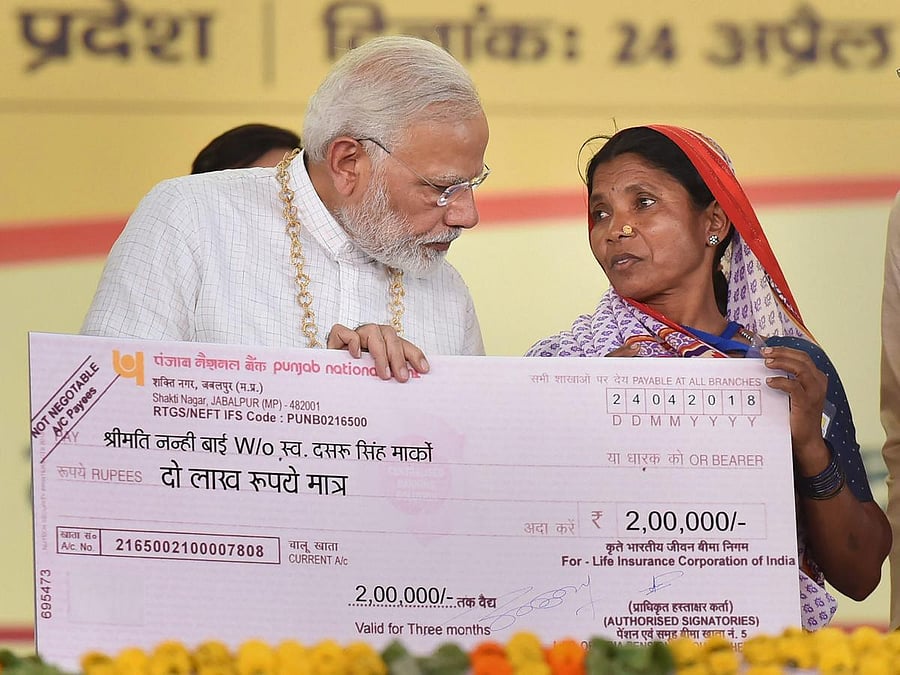During a Question Hour exchange with R K Singh, Minister of State (Independent charge) for Power and New and Renewable Energy in the last session of the 16th Lok Sabha, Congress’ Mallikarjun Kharge pointed out that the Narendra Modi government’s claim that they have electrified the whole of India, something which had not been done in the 70 years since Independence, was not true.
He said that when Modi took over as prime minister, only 18,000 villages remained to be electrified. He reminded that there were 6.5 lakh villages and hamlets in the country, and if the process of electrification had not proceeded apace over the decades, then the number of villages to be electrified would not have been a mere 18,000. This is but an indication of what the Modi government has tried to say for every initiative it took in the last five years.
Most of the time and in many of the sectors, the Modi government took forward many existing schemes. It is so with the Swachh Bharat initiative. The earlier governments had a financial scheme for the construction of latrines in the villages, but it was moving at a tardy pace. Modi galvanised it and in doing so made it an initiative of his government. It is a natural temptation for any politician to take credit where it is not due and to take more credit than is due.
According to the Ministry of Drinking Water and Sanitation, on October 2, 2014, when the Swachh Bharat Mission (SBM) was launched, 38.7% of Indian villages had toilets, which has gone up to 98.9% in February 2019. And 5,51,541 villages, 604 districts and 28 states and Union Territories have been declared Open Defecation
Free (ODF). It is an impressive jump indeed.
It reminds one of the Stakhanovite movement in the Soviet Union, where the workers competed with each other to produce more than they had to in their respective shifts. It started with miner Alexey Grigoryevich Stakhanov, who produced 102 tonnes of coal, a record, on 30 August 1935. It triggered a competitive spirit among the miners and soon Stakhanov’s record was broken. Targets were set by the mine managers and the targets were met, and in Stakhanovite fashion the targets were beaten.
It seems that the Modi government was not only meeting targets but it was exceeding them in Stakhanovite fashion. The question remains whether the crores of toilets in lakhs of villages continue to be used, continue to be maintained and, when they crumble, new ones are built to replace them.
The National Annual Rural Sanitation Survey (NARSS) 2017-18, conducted by an independent verification agency (IVA) under the World Bank project, shows that 93.4% households in rural India had access to toilets, and it confirmed the ODF status of 95.6% of villages. It also showed that 550 million people were defecating in the open at the time of the launch of SBM in October 2014 and that number had come down to 200 million in March 2018.
The National Sample Survey (NSS) 72nd round conducted between July 2014 and June 2015 showed that 45% of rural households and 89% of urban households had access to toilets and in the 75th round conducted between July 2017 and June 2018 showed tremendous improvement in rural areas with the households with access to toilets moving up to 64%, while it improved by 5% in the urban areas and stood at 94%. The SBM had made striking progress in the rural areas.
LPG connections
A landmark scheme is the Pradhan Mantri Ujjwala Yojana (PMUY). On January 2, 2019, the oil marketing companies achieved the six-crore target when Vice President M Venkaiah Naidu handed over a Liquid Petroleum Gas (LPG) connection to Jasmina Khatoon from Shiv Park, Khanpur, in Delhi. Union Minister for Petroleum and Natural Gas Devendra Pradhan said that in 50 years, 13 crore LPG connections were given, while the Modi government had given out a similar number in the last 54 months, and that the coverage of LPG connections in the country jumped from 55% to 90%.
The minister said that the initial target of five crore was achieved much before the target date of March 31, 2019 and that the facility has been extended to eight crore people, with a budgetary allocation of Rs 12,800 crore. He said that 74% of the beneficiaries who could not make upfront cash payment for the gas stove and the first refill were provided loans by the Oil Marketing Companies (OMC).
The teasing question is the extent of the loans extended by the OMCs, and the terms of repayment. Are these poor households in a position to repay the loans, or will it turn into a case of bad loans through no fault of the poor people upon whom the loans were generously forced? Have rural incomes generally gone up, which would have enabled the rural households to switch to gas stoves (a subsidised LPG cylinder, for which they have to pay, costs over Rs 500)?
The NABARD (National Bank for Agriculture and Rural Development) All India Rural Financial Inclusion Survey 2016-17 shows that the average monthly rural income is Rs 8,059, with that of agricultural rural households at Rs 8,931 and that of the non-agricultural households at Rs 7,269. There is also the fact that 57.6% of rural households own a television and 87% of them own a telephone or mobile. The Ujjwala scheme then is to be understood in the context of the changing rural household profile.
(The writer is a senior journalist based in New Delhi)
